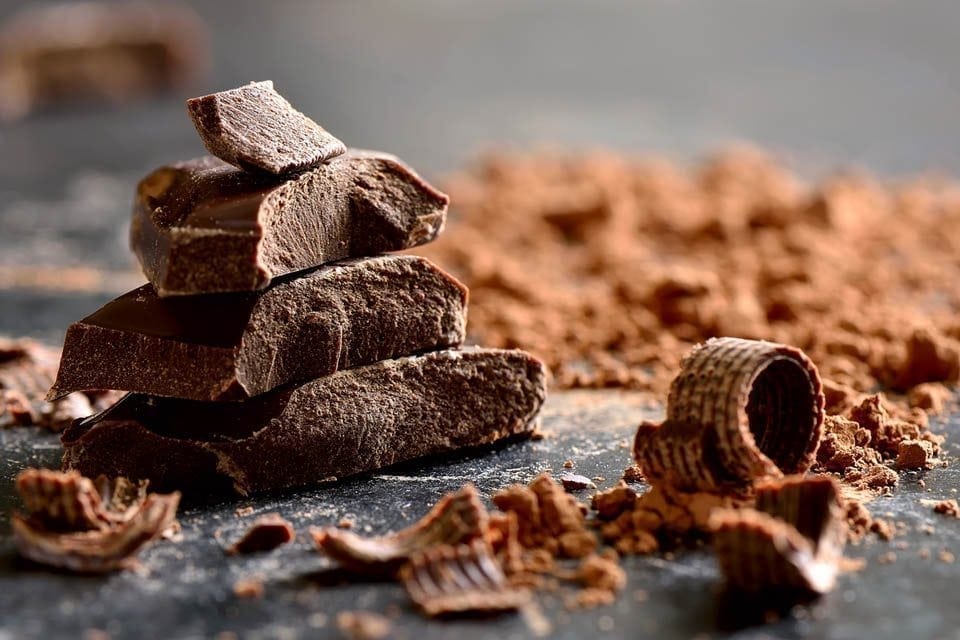Few foods can elicit the same kind of passion as chocolate. Whether it’s milk, dark or even white chocolate, you can’t deny its power to provide immense joy in the lives of those who love it.
Chocolate is also one of the few sweets known to impart health benefits for those who eat it regularly, but that doesn’t apply to just any chocolate. It’s important to distinguish between the different types of chocolate, as all are not nutritionally equal.
Chocolate 101
There are three main types of chocolate: milk, dark and white. All chocolate is derived from the oval fruit pods of the cacao tree. Each pod contains seeds that become cacao beans. Once the cacao beans are harvested and extracted from the pod, they go through a process of fermentation. After fermentation, the beans are dried, roasted and crushed into nibs (yes, the same cacao nibs you find in the grocery store). To make a chocolate bar, the nibs are ground into a paste called chocolate liquor. This liquor is then used to make chocolate bars, processed into cocoa butter or milled into cocoa powder.
Specific combinations of chocolate liquor, cocoa solids and cocoa butter, as well as milk and sugar are used to make different varieties of chocolate.
- Dark chocolate is characterized by the percentage of chocolate liquor. The higher the percentage of chocolate liquor found in dark chocolate, the less sugar and milk are present — and consequently, more health benefits.
- Milk chocolate contains less chocolate liquor and more sugar and milk than dark chocolate.
- White chocolate is actually not chocolate at all! While it does contain cocoa butter, it lacks the cocoa solids that are responsible for the color and roasted flavor of both milk and dark chocolate. Some white chocolate varieties don’t even contain enough cocoa butter to be called white chocolate (instead they use partially hydrogenated oils for some or all of the cocoa butter). Because of this trend, the FDA has required that a product must contain at least 20% cocoa butter, 14% milk solids, 3.5% milk fat and no more than 55% sugar to be labeled white chocolate.

Is Chocolate Good for You?
Ah, the million-dollar question! The answer is yes, to a degree, especially when it comes to your heart. The heart benefits are derived mostly from the antioxidant effects of plant sterols and a special flavonoid called flavonol, which is prevalent in cocoa beans.
In addition to their antioxidant effects, flavonoids and plant sterols have the potential to lower blood pressure and improve blood flow to both the brain and heart. Research also shows that a substance in cocoa powder may help lower LDL cholesterol (the lousy kind) and increase HDL (the good kind).
Chocolate may also help reduce insulin resistance, a risk factor for diabetes. One study published in the British Journal of Nutrition showed that eating 100 grams of chocolate per day (roughly one bar) resulted in reduced insulin resistance.
Lastly, chocolate may boost brain health. Research suggests that drinking two cups of hot chocolate each day may prevent memory decline by preserving blood flow in working areas of the brain. There’s also evidence that an extract found in cocoa may reduce damage to the nerve pathways seen in Alzheimer’s disease.
How to Get the Most from Chocolate
How can you enjoy chocolate without wrecking your diet? It’s all about choosing wisely, balancing calories and getting creative.
1. Opt for dark. First off, go for dark chocolate over milk chocolate, and choose the highest percent cacao you can tolerate. If you can stay above 70%, you’re on the right track. And don’t worry so much about the fat content. The fat in cocoa butter is made up of equal amounts of heart-healthy monounsaturated fat and stearic acid, a saturated fat that has little effect on cholesterol.
2. Practice portion control. Let’s be realistic, if you add a 500-calorie chocolate bar to your diet every day, you can expect to gain weight. Instead, use dark chocolate as a substitute for other sweet treats in your diet, not as an add-on, and try to stick to a 1-ounce serving.
3. Think outside of the (chocolate) box. Skip the chocolate bar, and find ways to add unsweetened cocoa powder to your favorite foods. You can add cocoa powder to smoothies, stir it into oatmeal, bake it into muffins or mix it into no-bake energy bars. You can even add a teaspoon to your coffee or use it as a spice when making savory dishes like tomato-based chili and black bean soup.




